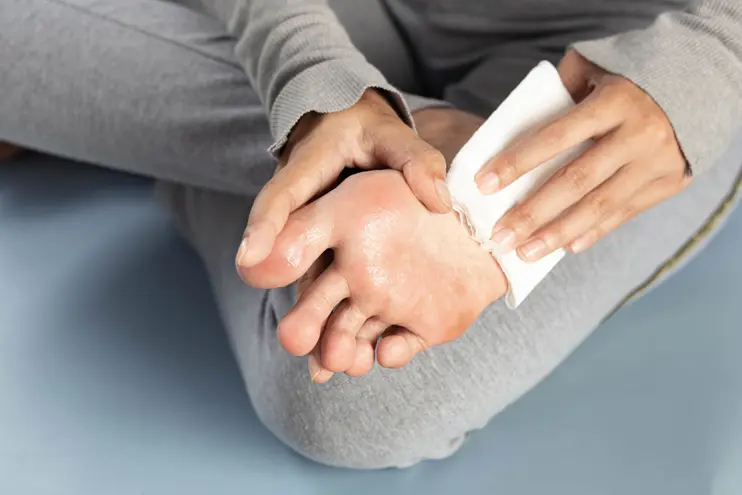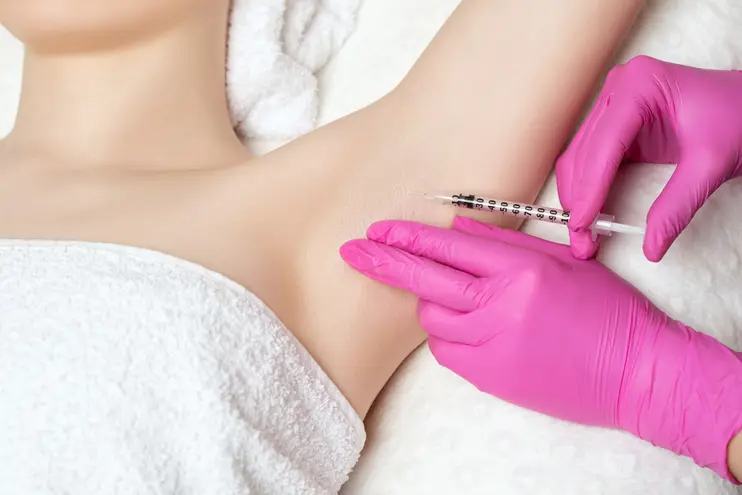Hyperhidrosis – Excessive Sweating
- Home
- Hyperhidrosis – Excessive Sweating
Our Doctor

Dr. Rahul Sheshgiri
Dermatologist & Cosmetic Doctor
Hyperhidrosis – Excessive Sweating

Introduction
Hyperhidrosis, commonly known as excessive sweating, is a medical condition characterized by abnormally high levels of perspiration beyond what is necessary for thermoregulation. While sweating is a natural bodily function designed to regulate body temperature, individuals with hyperhidrosis experience uncontrollable sweating that can significantly impact their quality of life. In this comprehensive guide, we delve into the world of hyperhidrosis, exploring its causes, symptoms, and effective treatment options to provide relief for those affected by this condition.
What is Hyperhidrosis?
Hyperhidrosis is a medical condition characterized by excessive sweating that occurs beyond what is necessary to regulate body temperature. While sweating is a normal response to heat, physical activity, or stress, individuals with hyperhidrosis may sweat profusely even in cool or relaxed environments. This can lead to persistent dampness, discomfort, and embarrassment, affecting various aspects of daily life, including work, social interactions, and personal relationships.
Types of Hyperhidrosis

There are two primary types of hyperhidrosis:
Primary Hyperhidrosis: Also known as focal hyperhidrosis, primary hyperhidrosis typically affects specific areas of the body, such as the palms, soles of the feet, underarms, or face. This form of hyperhidrosis is thought to be caused by overactive sweat glands and may occur without an underlying medical condition.
Secondary Hyperhidrosis: Secondary hyperhidrosis is characterized by excessive sweating that occurs as a result of an underlying medical condition or medication. This type of hyperhidrosis may affect larger areas of the body and often requires medical evaluation and treatment to address the underlying cause.
Causes of Hyperhidrosis
The exact cause of hyperhidrosis is not always clear, but several factors may contribute to its development:
Genetic Predisposition: There is evidence to suggest that hyperhidrosis may have a genetic component, with a family history of excessive sweating increasing the likelihood of developing the condition.
Overactive Sweat Glands: In individuals with primary hyperhidrosis, overactive sweat glands may play a role in producing excessive perspiration. These glands may be hypersensitive to stimuli that trigger sweating, leading to an exaggerated response.
Medical Conditions: Certain medical conditions, such as thyroid disorders, diabetes, menopause, obesity, and neurological disorders, may be associated with secondary hyperhidrosis. In these cases, addressing the underlying medical condition is essential to managing excessive sweating.
Medications: Some medications, including antidepressants, antipsychotics, and certain blood pressure medications, may cause or exacerbate hyperhidrosis as a side effect.
Symptoms of Hyperhidrosis
The primary symptom of hyperhidrosis is excessive sweating that occurs beyond what is necessary for thermoregulation. Individuals with hyperhidrosis may experience the following symptoms:
- Persistent sweating that occurs regardless of temperature or activity level
- Sweat that soaks through clothing and may be accompanied by visible sweat stains
- Increased frequency of sweating episodes, often triggered by stress or anxiety
- Skin irritation, chafing, or fungal infections in areas prone to sweating, such as the armpits, groin, or feet
- Emotional distress, embarrassment, or social withdrawal due to the impact of excessive sweating on daily life
Treatment Options for Hyperhidrosis

Fortunately, several treatment options are available to help manage hyperhidrosis and reduce excessive sweating. These may include:
Topical Antiperspirants: Over-the-counter or prescription-strength antiperspirants containing aluminum chloride can help block sweat ducts and reduce sweating in affected areas. These products are typically applied to the skin once daily, usually at bedtime.
Oral Medications: In some cases, oral medications such as anticholinergics may be prescribed to help reduce sweating by blocking the signals that stimulate sweat gland activity. However, these medications may have side effects and are not suitable for everyone.
Botulinum Toxin Injections: Botulinum toxin injections, commonly known as Botox, can be used to temporarily block the nerve signals that trigger sweat production. This treatment is particularly effective for focal hyperhidrosis affecting the underarms, palms, or feet and typically provides relief for several months.
Iontophoresis: Iontophoresis involves passing a mild electrical current through the skin while the affected area is immersed in water. This treatment helps temporarily block sweat gland activity and is often used to treat hyperhidrosis affecting the hands or feet.
Laser Therapy: Laser therapy, such as laser sweat ablation, uses targeted laser energy to destroy sweat glands in the affected area, reducing sweating. This minimally invasive procedure is typically performed under local anesthesia and offers long-lasting results.
Surgery: In severe cases of hyperhidrosis that do not respond to other treatments, surgical options such as sympathectomy or sweat gland removal may be considered. These procedures involve permanently disrupting the nerves or removing sweat glands to reduce sweating.
Conclusion
Hyperhidrosis, or excessive sweating, can have a significant impact on daily life, affecting both physical comfort and emotional well-being. However, with proper diagnosis and treatment, individuals with hyperhidrosis can find relief and regain control over their symptoms. Whether through topical treatments, medications, or minimally invasive procedures, there are effective options available to help manage hyperhidrosis and improve quality of life. If you or someone you know is struggling with excessive sweating, consult a healthcare professional for evaluation and personalized treatment recommendations. With the right approach, relief from hyperhidrosis is within reach, allowing individuals to live more comfortably and confidently.
What People Says!
Hear from our delighted clients as they share their experiences and stories of transformation. Your trust inspires us to keep delivering excellence!



